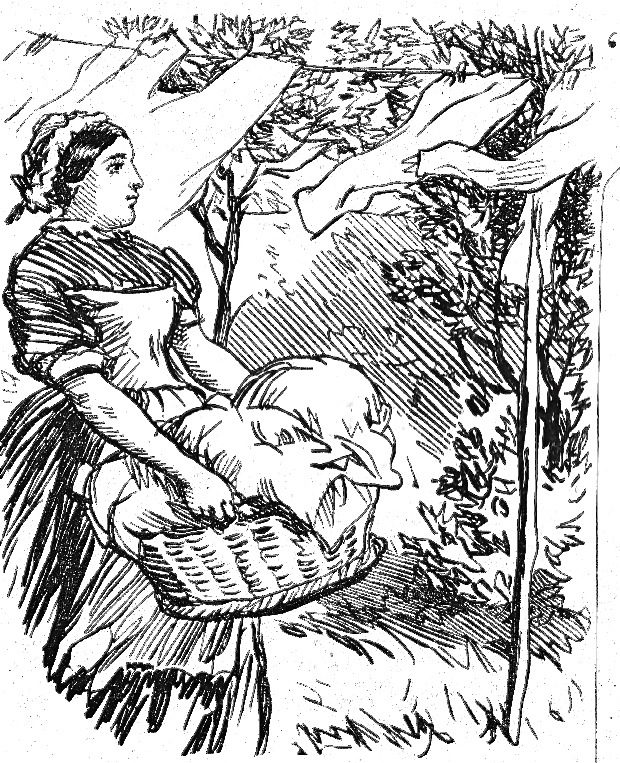This review is reproduced here by kind permission of Erika Rappaport and the online inter-disciplinary journal Cercles, where the review was first published. The original text has been reformatted and illustrated for the Victorian Web by Jacqueline Banerjee. [Click on the images to enlarge them and for more information about them.]

 mma Griffin’s new social history of the family uses autobiography
as a window into the working conditions, domestic economies and the gender
roles and expectations of working men and women in Victorian England. As such, Bread
Winner returns to many of the key issues that once animated British social
and women’s history between the 1960s and 1980s. In fact, the book’s themes and
the general portrait of the Victorian working class Griffin paints echoes that
of political economists, novelists, socialists, feminists, trade unionists and
social reformers writing since the early nineteenth century. Robert Owen,
Friedrich Engels, and Margaret Llewelyn Davies (one of the leading figures in
the Women’s Co-operative Guild), and so many others would have recognized the
experiences that Griffin recounts in Bread Winner.
mma Griffin’s new social history of the family uses autobiography
as a window into the working conditions, domestic economies and the gender
roles and expectations of working men and women in Victorian England. As such, Bread
Winner returns to many of the key issues that once animated British social
and women’s history between the 1960s and 1980s. In fact, the book’s themes and
the general portrait of the Victorian working class Griffin paints echoes that
of political economists, novelists, socialists, feminists, trade unionists and
social reformers writing since the early nineteenth century. Robert Owen,
Friedrich Engels, and Margaret Llewelyn Davies (one of the leading figures in
the Women’s Co-operative Guild), and so many others would have recognized the
experiences that Griffin recounts in Bread Winner.
Like a late-Victorian and Edwardian social investigator, Griffin asks why there was so much poverty despite growing wages and overall wealth in the nineteenth century? She seeks the answer in the life writing of those who lived through these times. Through a qualitative and quantitative analysis of approximately 650 published and unpublished working-class autobiographies written and collected largely in the mid-twentieth century, Griffin advances three primary arguments. She contends that “through autobiographies we can see the family as the motor by which wages and well-being moved through society, but we are also able to grasp what a deeply inegalitarian and inefficient motor the family was, riven with divisions of gender and age which determined who got what” (23). That is, Griffin argues that autobiography is an excellent source for the study of family dynamics and domestic economies; that the family and economy were not separate spheres; and that power and resources in the working-class family were unequally structured by age and gender. These facts shaped paid and unpaid work, notions of motherhood and fatherhood, marital or other family relations, emotional expressions, access to politics and citizenship, and the availability and nature of life writing.


Men unable to fulfil their roles. Left: John Gordon Thomson's cartoon in Fun (1887): "His Lordship to a Starving Workman: — 'Really, my good man, I do not quite see what I can do for you — unless — aw — You wish to be shot.'” Right: Thomas Faed's From Hand to Mouth: He was One of the Few Who Would Not Beg (1879).
The nine chapters explore then how gender structured male and female labor markets in rural and urban settings, mothers’ unpaid labor, fathers’ leisure, and other topics that demonstrate the uneven distribution of power and resources in the working-class home. At the heart of the book is the way in which men, women and children expected the father to be the “bread winner,” and the economic and emotional ramifications that followed from a father failing to live up to such expectations. Yet, as Griffin acknowledges, this was only half the story. Women worked relentlessly to keep up the fiction of the male bread winner. Indeed, Griffin is at her best when describing the intricacies of housework, including long forgotten tasks such as crushing salt blocks with a rolling pin, cleaning oven flues, making one’s own laundry soap and fashioning toilet paper from old newspapers that then had to be threaded on a piece of string (93). There is less material here on the type of unpaid but absolutely central economic tasks which Ellen Ross detailed in Love and Toil: Motherhood in Outcast London, 1870-1918 (Oxford University Press, 1993). Likely because women did not write about such things in their autobiographies, we learn less here about the skills involved in shopping for bargains, being a good haggler, or how to obtain credit at the neighborhood shop. We also learn little about prostitution, petty criminal activities or other things that writers no doubt did not wish to make public.


Women's poorly paid or unpaid work. Left: Frank Holl's Seamstresses (1875). Right: Women working in the countryside in around the 1870s.
Griffin has a deep empathy for her subjects and a concern to develop a comprehensive bibliography of working-class autobiography. She has an eye for detail and a skill for building patterns in a way that makes the book accessible. It will be widely read by non-specialists. However, the lack of direct engagement with previous or much contemporary scholarship (often something pushed by publishers these days) will undermine Griffin’s goal to encourage more mainstream economic historians to take gender and the domestic seriously. They simply won’t be able to see how the story she paints speaks to the issues they are currently concerned with nor would reading Bread Winner introduce scholars to the generations of historians of the family and gender whose seminal works have reframed understandings of class, economy and politics. Anna Clark, Leonore Davidoff and Catherine Hall, Ellen Ross, Barbara Taylor, Deborah Valenze, Judy Lown, June Purvis and so many others have explored the gendering of working-class politics, industrial labor, categories of skill and unskilled, the benefits and problems associated with the male breadwinner model, and the way in which domestic ideology helped make the middle class and unmake the working class. In my own work, I examine how the law, shop and private home became places in which men and women worked out shifting notions of class and property, agency and credit, money and goods (see especially Shopping for Pleasure, Chapter 2). For an imperial context, see my “Marriage, Celibacy, or Emigration? Debating the Costs of Family Life in Mid-Victorian England” and "‘The Bombay Debt’: Letter Writing, Domestic Economies and Family Conflict in Colonial India" [details in bibliography].

The value of housework. "Mrs Caudle has a 'short wash,'" Charles Keene's vignette in Mrs Caudle's Curtain Lectures, by Douglas Jerrold (1845).
Griffin is thus both right and wrong when she writes that women’s historians succeeded in “establishing domestic life as a subject to be taken seriously,” but failed to insert “the domestic into the mainstream " (5). What do we mean by mainstream? The scholars mentioned above, and those Griffin does cite have sought to challenge such terms and not just insert women into the story. Their work nevertheless is often cited in key textbook and appears on many a graduate reading list. The problem lies not with gender historians but with the ongoing gender, as well as racial and class inequalities in the historical profession. It also is in part a factor of the global turn, but there are excellent studies, such as Sherene Seikaly’s Men of Capital: Scarcity and Economy in Mandate Palestine (Stanford University Press, 2015) that have demonstrated how gender was central to the very invention of the idea of economy. Griffin’s Bread Winner, along with numerous articles documenting how our current global pandemic has accentuated women’s double burden around the world, have reminded us however that the family and the economy are not separate spheres. So too have several important “intimate” histories of the British economy, welfare state, industrialization and imperialism. James Vernon’s Hunger: A Modern History (Harvard University Press, 2007); Nadja Durbach’s Many Mouths: The Politics of Food in Britain from the Workhouse to the Welfare State (Cambridge, 2020) and Christopher Otter’s Diet for a Large Planet: Industrial Britain, Food Systems and World Ecology (Chicago, 2020) reveal how ideas about hunger and food shaped the modern British state, industrialization, imperialism and the environmental problems currently associated with the modern global economy. Also important is Priya Satia’s prize-winning Empire of Guns: The Violent Making of the Industrial Revolution (Penguin, 2018) which traces how family, religion, gender, race, empire and violence were integrally connected to Britain’s so-called Industrial Revolution. Finally, a number of current scholars have returned to a very old and yet salient question of whether the profits from slavery shaped Britain’s industrial and consumer revolutions: many are benefiting from new digital sources and databases such as University College London's The Legacies of British Slave Ownership (again, see bibliography). These studies of food, commodities, empire and racial capitalism have not neglected gender and the family, but we would do well to heed Griffin’s call and remember that working men and women fashioned if they rarely profited from transformations in the Victorian economy.
Related Material
Bibliography
[Book under review] Griffin, Emma. Bread Winner: An Intimate History of the Victorian Economy. New Haven and London: Yale University Press, 2020. Hardcover. xi + 389 pages. ISBN 978-0300230062. $35/£20
The Legacies of British Slave-ownership Database (University College London).
Rappaport, Erika. "'The Bombay Debt': Letter Writing, Domestic Economies and Family Conflict in Colonial India." Gender and History. 16/2 (August 2004): 233-260.
_____. “Marriage, Celibacy, or Emigration? Debating the Costs of Family Life in Mid-Victorian England”. In Lana L. Dalley and Jill Rappoport, eds., Economic Women: Essays on Desire and Dispossession in Nineteenth-Century British Culture. Athens, Ohio: Ohio University Press, 2013: 143-161.
_____. Shopping for Pleasure: Women in the Making of London’s West End. Princeton, NJ: Princeton University Press, 2000. See Chapter 2.
Created 3 February 2021